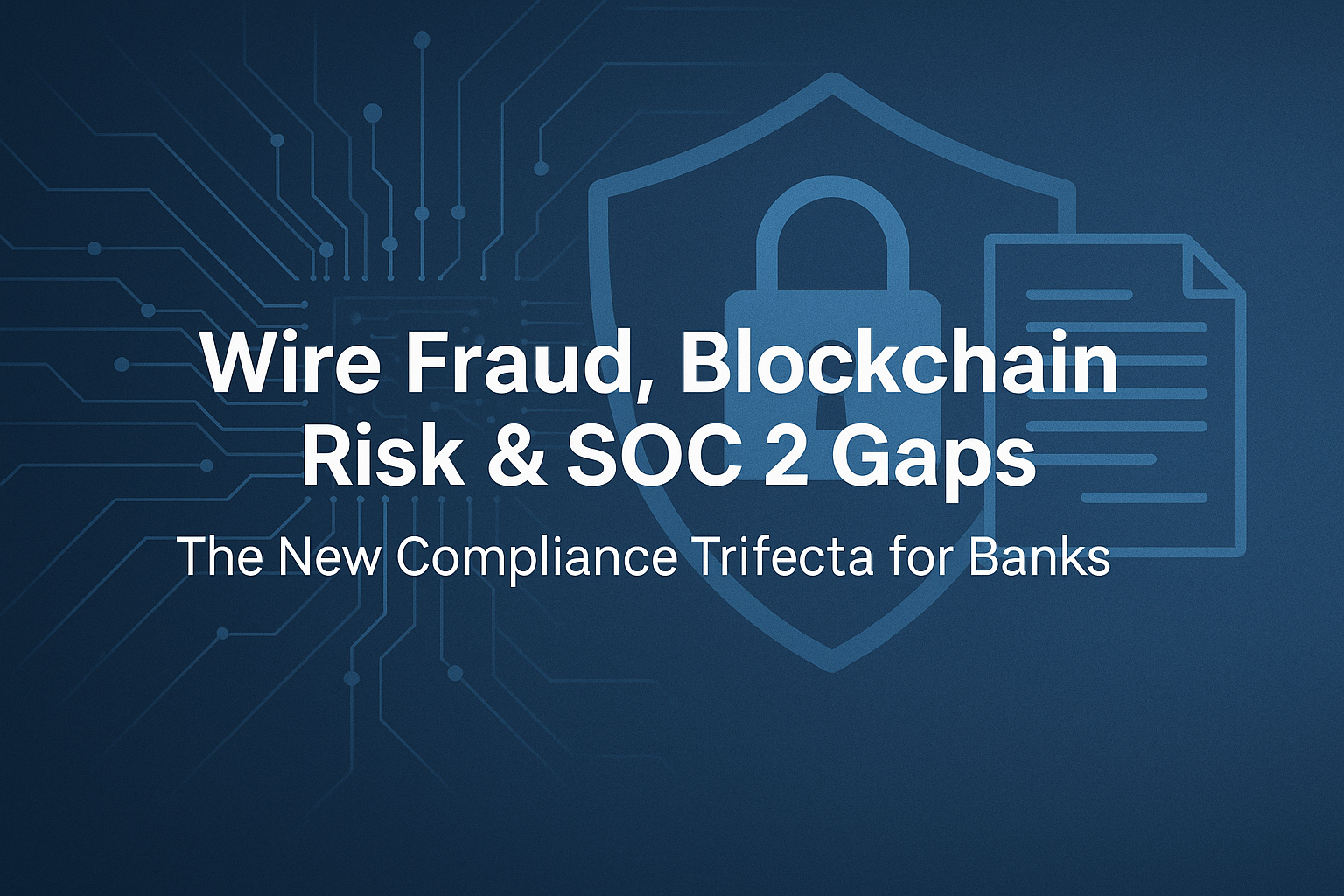Community and regional banks are entering a perfect storm of cybersecurity and compliance risk. Between international wire fraud tied to blockchain transactions, growing SOC 2 audit pressure, and neglected incident response planning, institutions face mounting exposure from both regulators and attackers.
For bank executives and compliance officers, the message is clear: traditional safeguards aren’t enough. The intersection of financial crime, regulatory accountability, and operational readiness now defines banking resilience.
The Modern Wire Fraud Problem: Blockchain’s Double-Edged Sword
In 2025, blockchain’s role in global payments continues to expand but so does its abuse. Fraudsters now exploit crypto-enabled rails and cross-border payment ecosystems to disguise origin, route, and intent.
The Pain Points
- Cross-border vulnerability: Decentralized rails reduce transaction traceability, complicating fraud detection.
- Regulatory blind spots: Few banks fully understand or document blockchain-related compliance obligations under AML / CTF frameworks.
- Reputational damage: One compromised wire or crypto-linked transaction can cascade into legal exposure and loss of customer trust.
As BHCA leaders and compliance officers at institutions like First American Bank have warned, this isn’t just a technology issue, it’s a fiduciary and regulatory responsibility.
The Saturn Partners Solution
Our team helps financial institutions establish fraud-resistant international wire controls that align blockchain transaction monitoring with established banking governance. We:
- Integrate AI-assisted anomaly detection for cross-border transaction behavior.
- Implement transaction tracing and digital-asset risk screening.
- Map AML / KYC compliance workflows to blockchain transaction data.
- Provide executive-level reporting frameworks that meet both regulator and board expectations.
SOC 2 Compliance: The New Benchmark for Banking Credibility
More banking clients and vendors are demanding verifiable proof of secure data handling and that means SOC 2 readiness. Yet most internal IT teams are stretched thin, struggling to interpret auditor expectations or implement required controls.
The Pain Points
- Limited internal bandwidth: Small security teams can’t keep up with SOC 2 documentation and evidence collection.
- Control overlap confusion: Many banks duplicate GLBA, FDICIA, and SOC 2 controls unnecessarily, wasting resources.
- Audit fatigue: Institutions often approach SOC 2 reactively, not as a continuous readiness cycle.
The Saturn Partners Solution
We conduct comprehensive SOC 2 gap analyses that help banks understand where they stand and what it takes to achieve compliance efficiently. Our approach includes:
- Control mapping to GLBA, ISO 27001, and FFIEC guidance.
- Automated evidence collection frameworks to reduce manual workload.
- Readiness dashboards for executive and auditor transparency.
- Roadmaps for audit readiness that align technical, procedural, and governance layers.
With our guidance, financial institutions move from “audit scramble” to continuous assurance, turning SOC 2 from a box-checking exercise into a strategic differentiator.
For deeper insight into how technology, automation, and governance intersect in compliance, see our related article on Generative AI Banking Compliance: Balancing Innovation & Risk
Incident Response Planning: The Forgotten Discipline
Despite increasing threats, most banks still fail to maintain, test, or document their incident response plans (IRPs). A written plan sitting on a shared drive won’t help during a ransomware or data-exfiltration event.
The Pain Points
- Outdated IRPs: Many haven’t been revised in over 12 months.
- Lack of exercises: Few institutions conduct tabletop simulations involving executives, IT, legal, and communications teams.
- Compliance risk: Regulators now expect proof of IRP testing and escalation protocols as part of audit cycles.
Regulators now expect proof of IRP testing and escalation protocols as part of audit cycles. According to the Federal Reserve’s guidance on cybersecurity and operational resilience, banks must ensure that information systems and continuity plans can withstand disruptions from any hazard — whether from cyberattacks, vendor outages, or operational failures.
The Saturn Partners Solution
We bring structure and realism to incident response. Our banking-specific IRP service includes:
- Custom IRP development aligned with GLBA, FFIEC, and NIST CSF.
- Executive tabletop exercises simulating wire-fraud or ransomware events.
- After-action reporting and documentation for regulatory evidence.
- Integration with SOC monitoring and escalation frameworks for 24/7 coverage.
With structured testing, leadership confidence rises and so does resilience during real-world crises.
The Bottom Line: Compliance Without Capacity Is a Hidden Risk
The compliance landscape isn’t slowing down, it’s splintering. From blockchain oversight to SOC 2 audits and IRP maintenance, the burden is rising even as internal resources shrink.
Banks that treat these obligations as isolated checkboxes risk fragmentation. The smarter path is convergence, a unified compliance and cybersecurity framework that consolidates policies, testing, and continuous improvement.
How The Saturn Partners Can Help
At The Saturn Partners, we specialize in bridging the gap between compliance frameworks and cybersecurity execution. Our experts:
- Conduct wire-fraud risk assessments for blockchain and cross-border payment systems.
- Deliver SOC 2 readiness and audit support tailored to banking environments.
- Build and test incident response frameworks that satisfy both regulators and real-world resilience.
If your institution is feeling the weight of these parallel challenges, we can help you transform compliance pressure into operational confidence.
Talk to our experts about building a connected governance model that protects your assets, customers, and reputation from wire transfer to audit trail.

